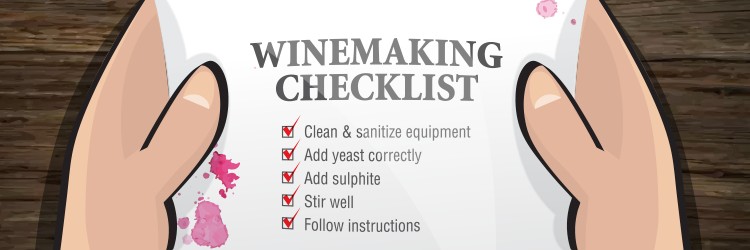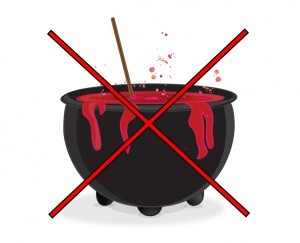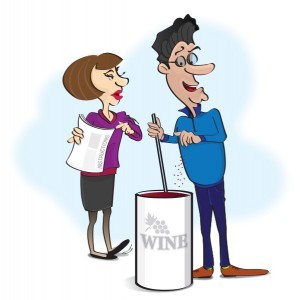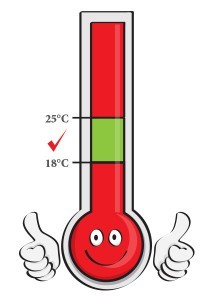Craft & Cork >> Winemaking

Common craft winemaking mistakes (and how to avoid them!)
The winemaking team at RJS Craft Winemaking has been helping craft winemakers perfect the art of making craft wine for over 50 years. We have seen many amateur winemakers make outstanding, even award winning, craft wines. However, we have also seen our fair share of winemaking blunders over the years. Here is a list of the most common mistakes made by craft winemakers, and more importantly, what you can do to avoid making them yourself!
Poor Cleaning & Sanitation
Most winemaker’s know they need their equipment to be sparking clean before making their wine. But, too many amateur winemakers mistakenly think that cleaning and sanitizing are the same thing. Let us assure you they are very DIFFERENT! While cleaning with detergent will get rid of visible residue, sanitizing goes a step further and requires treating equipment with a substance that will inhibit or kill bacteria.
There are several sanitizers you can use, including metabisulphite solution, and they all work a little differently. Clean and sanitize everything that touches your wine — fermenters, carboys, hoses, thermometers, spoons. It’s easy and worth it: 90% of winemaking failures in wine can be traced to poor cleaning or faulty sanitation.
 Using the wrong type of equipment
Using the wrong type of equipment
When you start making your wine, don’t just grab anything you see around the house—like your Grandma’s old pickle jars, peanut butter pails, garbage cans, or wooden spoons. These can’t be sanitized easily and are very likely to taint your wine. While we appreciate your resourcefulness, proper winemaking equipment is made of food-grade plastic or glass and is designed to give you the best results possible.
 Ignoring or Changing the Instructions
Ignoring or Changing the Instructions
No one likes to be told what to do, but our development team has studied our wine kits endlessly… so trust us! Follow all instructions carefully as these are proven procedures for getting the best possible results from the ingredients in the kit.
Not adding Sulphite
No one wants to drink wine that tastes off. Sulphite prevents your wine from spoiling, so please don’t leave it out! Bad things can happen to your craft wine if you leave out the Sulphite.
 Not adding yeast correctly
Not adding yeast correctly
We recommend sprinkling the yeast over the surface (at 18 to 25 degrees Celsius) juice and not stirring. If the temperature is wrong, the yeast won’t be happy. And if you stir it in, you can suffocate it.
Not Stirring Enough
Eventually you will need to clear your wine by adding natural substances like chitosan, keiselsol, and a clay called bentonite. These come with the kit and need to be dispersed thoroughly throughout the wine. This means stirring….and stirring….and stirring. Even if your arm gets sore, keep stirring!
Not Topping Up Your Wine
Don’t forget to top off your wine to prevent it from oxidizing. Minimizing the air space above the wine is crucial to keeping your batch of craft wine delicious.
In our decades of craft winemaking experience, these are the issues that are most likely to cause a batch of wine to go sideways. By avoiding these common mistakes you’re one step closer to a beautiful batch of your very own craft wine.


Thank you. I have unfailingly followed these guidelines and have not had a bad batch in 25 years of winemaking
Can there be an air space above the wine in the primary (if yes, how much?)
Hi Anthony,
If you are crafting your wine with the recommended 30 litre primary fermenter, you should fill your Primary to the 23 litre mark and allow the remainder for airspace. Within 2 days, your wine will show signs of fermentation. (bubbling or foaming). For more information, reference the instructions included in your wine kit or access the instruction online.
Hi! I am allergic to shellfish and I see that the wines I am looking at contain chitosan. Is there anything I can substitute this with? Any help would be greatly appreciated!
Thank you!
In the way that chitosan is made, it does not retain the proteins that would normally cause an allergic reaction. In wine making, chitosan is removed from the wine after it has served its clearing purpose, so any residual chitosan and risk of protein contamination would be extremely minute. We have a staffer with a shellfish allergy who regularly enjoys craft wine and has never had an allergic reaction from the wine. If you are still concerned, you can try Sparkolloid instead. Here is the process for adding Sparkolloid which can be found at some local craft winemaking shops:
Sparkolloid Addition
1. Stir 10 grams (3 TBSP) of Sparkolloid into 300 mL of boiling water.
2. Boil for 2 minutes, stirring well to completely dissolve.
3. SLOWLY add this mixture to your 23 liter batch and add while still hot. (Should take 2 minutes to add all 300mL while stirring).
4. Stir wine thoroughly once added and ensure that carboy is topped up.
5. Place carboy in the coolest spot possible to encourage fast clearing (10-15°C)/(50-59°F).
6. You should see clearing within 24-48 hours.
7. Wait at least 7-10 days before racking off of sediment in preparation for bottling.
I am making Pinot Gregio , which is a white wine but I am almost at the end of the process and should be bottling it next week, but the wine is very dark. Is there something I can do to lighten it.
Hi Bonnie,
Thank you for reaching out. Please contact your local home winemaking shop with any questions, or in Canada and the United States call our toll-free help line 1-800-663-0954 or email us at rjsinfo@arterracanada.com to receive assistance.
-RJS Craft Winemaking team